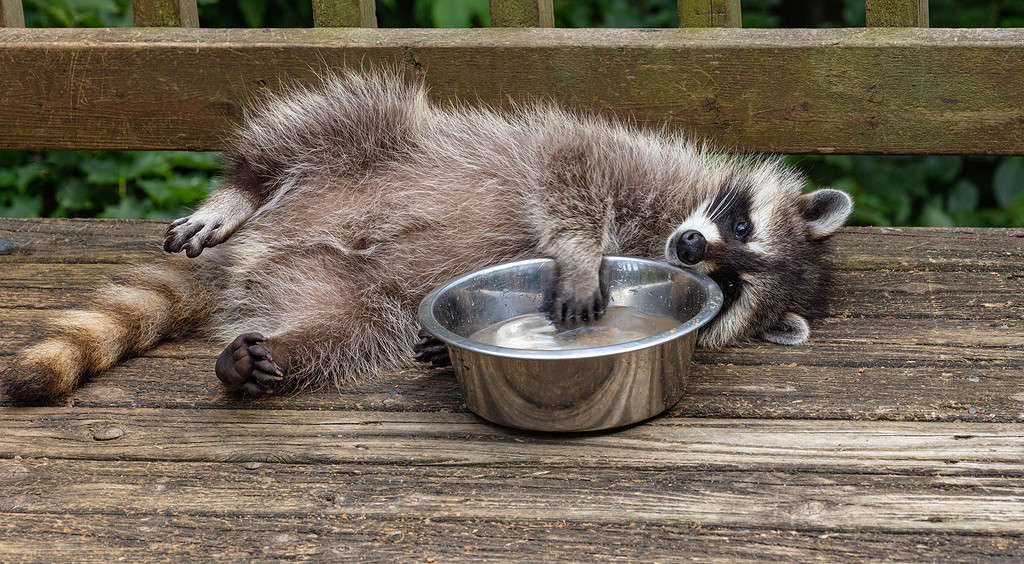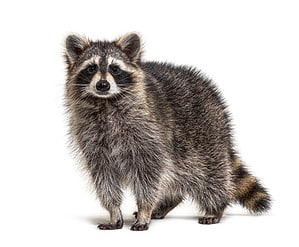Raccoons possess surprisingly solid swimming abilities. It is not uncommon to find these scavengers wading through lakes, streams, or even swimming pools. Raccoons do not swim merely to cool down or for pure enjoyment. These animals use water sources as hunting grounds for food. Learn interesting facts about raccoons swimming.

Believe it or not, raccoons possess superior swimming abilities.
©iStock.com/amadeusamse
When people think of words used to describe raccoons, predators, pests, and sneaky, they often come to mind. However, swimmers probably appear far down on anyone’s list of descriptive terms. That said, the creature known scientifically as Procyon lotor demonstrates solid skills in the water.
Brief Overview
Scientists label raccoons as mammals. These critters hold specific, well-known physical characteristics.
Appearance
The animal’s most distinctive feature is the black coloring around its eyes and face. Certain zoologists maintain that these famous markings protect the raccoon against potential hazards like sun glare. Additionally, the creatures possess thick layers of greyish-brown fur designed to protect them against cold temperatures. Interestingly, the raccoon’s back legs extend longer than its front ones.
Length and Weight
Typically, a raccoon’s length extends anywhere from two to three feet. Furthermore, the animal’s usual weight ranges from 14 to 23 pounds but can be heavier. Males are called boars. Females are known as sows. Kits is the name given to raccoon offspring.
Lifespan
On average, raccoons live for up to three years. However, when held captive, they commonly live for much longer durations.
Habitat
Raccoons typically live close to water sources because such locations contain the creatures they commonly feed on. However, raccoons often make their homes in trees and burrows. That said, they possess a highly adaptive nature and can thrive in any area, enabling them to find plentiful food sources, including more urban settings. Raccoon populations exist throughout the United States.

A significant amount of a raccoon’s diet comes from water sources.
©Anne Wright Dobbelsteyn/iStock via Getty Images
Interesting Facts About Raccoons Swimming
As swimmers, raccoons display:
Deliberateness
Raccoons follow the well-known adage stating that slow and steady wins the race. The animals typically wade through water at an average speed of three miles per hour. That said, they do possess the ability to swim faster if the need arises. This is especially true when pursuing prey.
Occasional Agitation
Despite their reputations as capable swimmers, raccoons often display agitation while immersed in water. Animal experts blame this occurrence on a raccoon’s body weight. In many cases, the creature carries enough pounds to make floating in water difficult. Repeated incidents of sinking increase the raccoon’s anxiety levels.
The Ability to Spend Hours in the Water
Raccoons have no idea what the expression taking a quick dip means. When these animals enter the water, they remain inside it for extended periods. Typically, the black-faced critters spend at least two hours in a given water source. However, it is not uncommon for them to spend far longer timeframes in water. One must remember that their thick fur protects them from cold.
The Ability to Remain Immersed for Long Periods
Raccoons can remain underwater for far longer stretches than humans can. The creatures practice breathing techniques that allow them to go without oxygen for as long as several minutes safely. Most people last up to only one minute underwater before feeling potentially dangerous side effects.
The Skill to Swim at Notable Depths
When raccoons dive into a water source, they do not shy away from the deeper portions. The animal’s ability to remain immersed for prolonged times enables them to travel through deeper, darker areas comfortably. Depths of five feet or greater have little effect on a raccoon’s swimming abilities.
The Comfort of Swimming in Cold Water
Usually, water temperatures clock in at colder readings than an animal’s normal body temperature. Therefore, spending an extended duration inside a water source naturally drops a creature’s body temperature and typically requires them to return to dry land after relatively brief periods.
A previous paragraph illustrated that a raccoon’s fur safeguards against cold brought forth by spending time immersed in water. However, the creature’s fur also enables it to stay in quite cold bodies of water for extended periods.
The Skills to Gather Food
Raccoons do not swim purely for the joy of spending time in water. Their primary purpose for entering a water source is to gather food. The animals feast on numerous creatures that call the water home, such as fish, shellfish, and insects.
Superior Hunting Abilities
A raccoon’s claws bear incredible strength. This asset makes them adept at capturing sea creatures they use as food sources.
The photo featured at the top of this post is © emcrea, Sans and Sons, Tive and Studio, edbo23/ via Canva.com
Thank you for reading! Have some feedback for us? Contact the AZ Animals editorial team.







